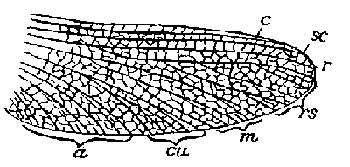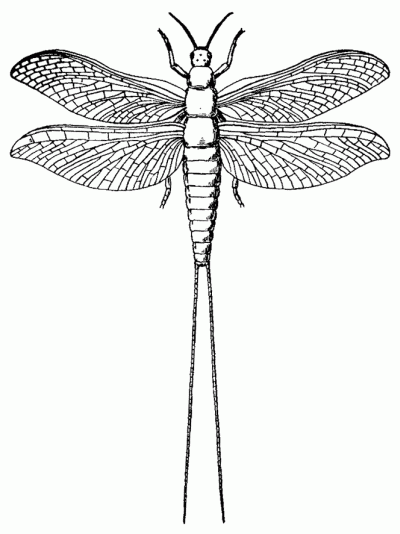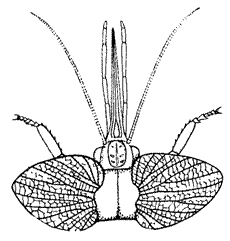 Lithomantis carbonarius Woodward 1876 (Palaeodictyoptera - Lithomantidae), Lanark: Scotland, Westphalian B (Early Moscovian, early Late Carboniferous).
Lithomantis carbonarius Woodward 1876 (Palaeodictyoptera - Lithomantidae), Lanark: Scotland, Westphalian B (Early Moscovian, early Late Carboniferous).| Palaeodictyopteroida | ||
| Arthropoda | Palaeodictyopteroida |
| Index | Arthropoda | Pterygota
└─► |
Palaeodictyopteroida | |
| Pterygota | Ephemeroptera |
|
Abbreviated Dendrogram
|
Contents
Overview |
Taxa on This Page
 Lithomantis carbonarius Woodward 1876 (Palaeodictyoptera - Lithomantidae), Lanark: Scotland, Westphalian B (Early Moscovian, early Late Carboniferous). Lithomantis carbonarius Woodward 1876 (Palaeodictyoptera - Lithomantidae), Lanark: Scotland, Westphalian B (Early Moscovian, early Late Carboniferous). |
The Palaeodictyopteroida were a diverse assemblage of mostly large, rather solidly built paleopterous insects, which were widespread in the Late Carboniferous. We treat them as a paraphyletic assemblage, but cover our backsides by reserving the use of "Palaeodictyoptera" for some possible monophyletic group of these insects. Thus comfortably talking out of both sides of our mouths, we proceed to a description.
The largest had wingspans 20 to 50 cm across. The Palaeodictyopteroida are usually regarded as the most primitive winged insects so far known to have existed. The wings were subequal (i.e. fore and hind pairs similar), sometimes widened, occasionally triangular. The most interesting thing about these insects is the presence of paranota (fore-wings) on the first thoracic segment. These are quite large and sometimes with rudiments of venation.
Despite their ancient status, the Palaeodictyopteroida already displayed specializations in that most, if not all, had mouth-parts modified into a long, suctorial rostrum - that is, piercing-sucking mouthparts for feeding upon plant sap. This was not, however, the same as the hemipteran rostrum, but rather represented an independent (an earlier) adaptation to feeding on spores, pollen, fruit, etc.
 Diagram of the neuration of a Palaeodictyopteran-grade primitive insect wing. The principal longitudinal veins are connected by a network of cross -veins, c, Costa ; sc, Subcosta; r, Radius; rs, Radial sector; m, Media; ru, Cubitus; a, Anal veins or nervures (after Handlirsch), from Zittel & Eastman 1913, fig 1531 |
The paleodictyopteroid wing (left) is generally taken as the ancestral type from which the other types evolved. There is a complete system of venation, typically with the concave components (Rs, MP, CuP) arising as posterior branches from the convex components, and with a fully developed cubito-anal field which was sometimes more or less expanded. The cross-veins are numerous, and regular or irregular.
The antennae are setose (bristly), the legs slender, abdominal segments usually with prominent lateral lobes, with cerci (two "tails") that are usually rather short, and no caudal style. Some species were more slender, with reduced lateral processes and long cerci. MAK000108, slightly modified by ATW

Palaeodictyopteroida (Rohdendorf, 1961) (sensu Bechly 1996)
Synonyms: Dictyoneuridea Handlirsch, 1906, Palaeodictyopteroidea Rohdendorf, 1961, Palaeodictyopteroida Müller 1978, Palaeodictyopterida Grimaldi & Engel 2005
Mid Carboniferous to Late Permian
Phylogeny: Pterygota : Rhyniognatha + (Ephemeroptera + Odonatoptera + Neoptera + * : Palaeodictyoptera + (Megasecoptera + (Permothemistida + Diaphanopterodea))))

Characters: highly derived sucking-piercing mouth-parts forming a prominent rostrum or proboscis (Haustellum) that consists of 5 stylets (most likely the two mandibles, two galaeo-laciniae, and the hypopharynx), correlated with a highy domed clypeus (clypeal sucking pump); presence of hollow filamentous projections on the posterior edges of thoracic and abdominal terga (dubious character); adult epiproct (paracercus or terminal filum) suppressed (convergent to Neoptera and Panodonata); well developed prothoracic and abdominal paranota expanded laterally (maybe caused by a secondary fusion of winglets or gills with the terga, correlated with a terrestrial mode of life of the larvae); terrestrial larvae without abdominal gills. - Günter Bechly, 2007
Characters: Head moderately large, rounded, ivith simple antennae, mouth parts adapted for biting, and well-developed jaws. Two pears of wings, subequal in size, of similar form and frimitive venation, incapable of being folded backward over the abdomen ; sometimes a rudimentary third pair present on the first thoracic segment. Abdomen consisting of ten nearly homonomous segments which often exhibit pleural lobes. Terminal segment often with much elongated cerci. Thoracic legs similar. - Zittel & Eastman 1913
Comment: Palaeozoic beaked insects, characterised by unique mouthparts consisting of 5 stylets. They represent the first important terrestrial herbivores, and the first major group of herbivorous insects. They appear during the Middle Carboniferous (late Serpukhovian/early Bashkirian), along with the other major winged insect clades, and continue through to the Late Permian; being teh only major group of iunsects to duie out at the end Permian extinction. Exact phylogenetic relationships with other paleopterans are unclear, we follow Grimaldi & Engel (2005) out of convenience. This large and diverse group includes 50% of all known Paleozoic insects. MAK120516, incorporating Wikipedia
The oldest name for this taxon, according to Russian entomologist N.D. Sinitshenkova Dictyoneuridea Handlirsch, 1906, but this is almost never used. The most common name seems to be Palaeodictyopteroidea Rohdendorf 1961, which is used, for example by the Tree of Life project. Bit according to Professor N.J. Kluge's Nomina Circumscribentia Insectorum database this refers to Palaeodictypotera + Archodonata + Ephemeroptera , and is therefore a paraphyeetic or polyphyletic taxon. Palaeodictyopteroida Müller 1978 would be prefereble as referring to Palaeodictyoptera only. this amended spelling was independently used by Bechly, who pointed out that the suffix "-oidea" is reserved for superfamilies. Grimaldi & Engel 2005 suggested a slightly different spelling again, replacing "-oida" with "-ida", in order to give the taxon superordinal rank, and this spelling was been widely adopted and hence has become the standard one. But as superorders, unlike superfamilies, seem to have variable suffixes, and can just as easily end in -oida as -ida, there probably is little necessity for this latter change MAK120522
Image: Top right, Homaloneura ornata Brongniart 1893 (Palaeodictyoptera - Spilapteridae) from Commentry Shales Formation of France, a Gzhelian lacustrine deltaic shale (ref Paleobiology database)., Upper left, Stenodictya, unfortunately I don't remember where I found either of these images
Links: Phylogenetic Systematics of basal Pterygota and Stem-Group Odonates - Günter Bechly,Wikipedia, Paleobiology database, Evolution of Insects in terms of the Implicate and Explicate Orders. MAK120522
| Index | Palaeodictyopteroida |
page MAK120522; Creative Commons Attribution;